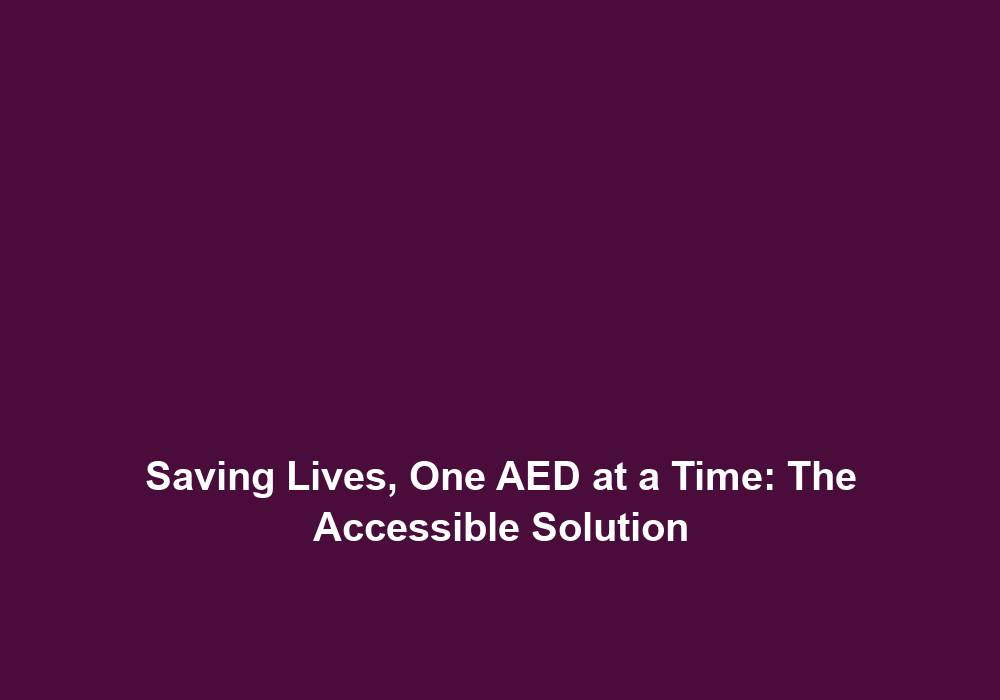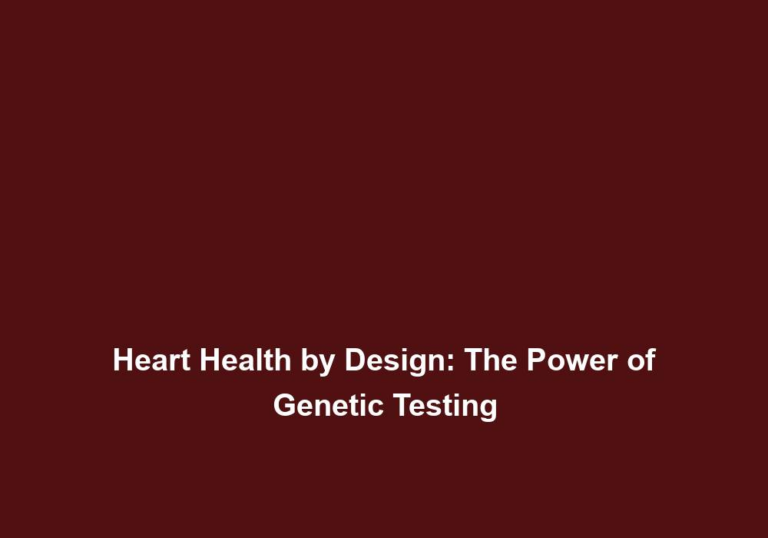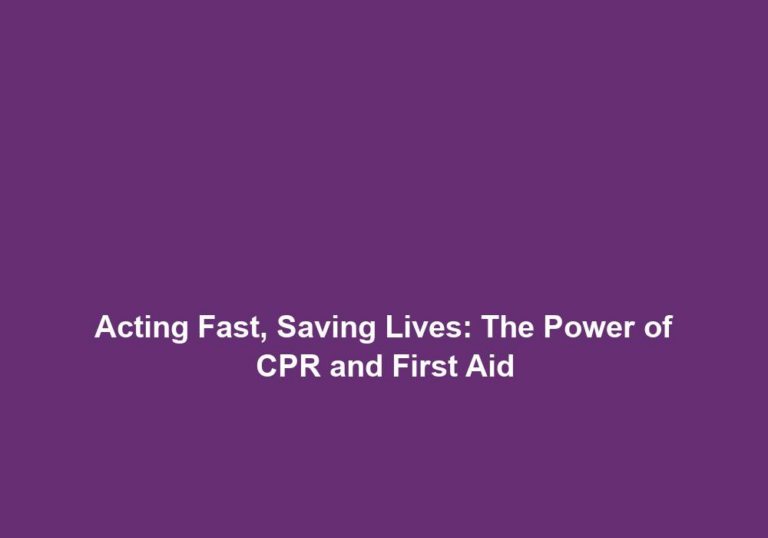Saving Lives, One AED at a Time: The Accessible Solution
Life can be unpredictable, and emergencies can strike at any given moment. In such situations, every second counts, especially when it comes to saving lives. One of the most critical factors in improving survival rates for cardiac arrest is the availability and accessibility of Automated External Defibrillators (AEDs). These lifesaving devices are designed to deliver electric shocks to the heart in order to restore its normal rhythm. With their user-friendly design and intuitive operation, AEDs are becoming increasingly accessible and are playing a crucial role in saving lives around the world.
The Importance of AEDs in Saving Lives
Cardiac arrest is a serious condition that occurs when the heart suddenly stops beating effectively. Without immediate intervention, it can lead to irreversible brain damage or even death within minutes. However, quick access to an AED can significantly increase the chances of survival. AEDs are capable of analyzing a person’s heart rhythm and delivering an electric shock if necessary, effectively restarting the heart. Immediate CPR combined with the use of an AED can improve survival rates by up to 70%.
AEDs not only provide a quick response to cardiac arrest but also play a crucial role in reducing the time it takes to restore the heart’s normal rhythm. These devices are designed to be easy to use, even for individuals without medical training. They come with clear visual and audio prompts that guide users through the entire resuscitation process. From properly applying the pads to administering a shock and performing CPR, AEDs provide step-by-step instructions, ensuring that even inexperienced individuals can confidently and effectively respond to emergencies.
Furthermore, AEDs are equipped with advanced technology that allows them to analyze a person’s heart rhythm and determine whether a shock is required. This automated process ensures that the right treatment is delivered promptly, minimizing the risk of delays or errors. The user-friendly design and intuitive operation of AEDs make them accessible to anyone, empowering individuals to take immediate action and potentially save lives.
AEDs: User-Friendly and Accessible
One of the key reasons for the widespread adoption of AEDs is their user-friendly design. These devices are specifically developed to be operated by individuals without medical training, making them accessible to anyone in an emergency situation. With clear visual and audio prompts, AEDs guide users through the entire resuscitation process, providing step-by-step instructions on how to properly apply the pads, when to administer a shock, and even guiding users through CPR techniques.
AEDs are designed to be intuitive and easy to use, even for individuals who have never received any medical training. They are equipped with user-friendly interfaces that provide clear instructions and guidance throughout the resuscitation process. Visual prompts, such as diagrams and illustrations, help users properly position the electrode pads on the chest of the person experiencing cardiac arrest. These prompts also indicate the correct hand placement and depth for performing CPR, ensuring that users can confidently provide effective chest compressions.
In addition to visual prompts, AEDs also feature audio instructions that guide users through each step of the resuscitation process. Clear and concise voice commands provide reassurance and clarity, helping users stay calm and focused during a high-stress situation. The combination of visual and audio prompts makes AEDs accessible to individuals of all backgrounds and experience levels, enabling them to take immediate action and potentially save lives.
AED Placement: Increasing Accessibility
To maximize the effectiveness of AEDs, strategic placement is crucial. AEDs should be readily available in public spaces where large numbers of people gather, such as shopping malls, airports, schools, and sports stadiums. Placing AEDs in easily accessible locations increases the likelihood of their use in the event of an emergency. Additionally, AEDs should be conveniently located in workplaces and residential buildings to ensure rapid response times during sudden cardiac arrest incidents.
Strategic placement of AEDs plays a vital role in improving accessibility and response times. Public spaces that attract a high volume of people should have AEDs prominently displayed and easily accessible. This includes placing AEDs in visible and well-marked locations, such as near entrances, main walkways, or high-traffic areas. By having AEDs readily available in these areas, bystanders and trained individuals can quickly retrieve the device and initiate life-saving measures before professional help arrives.
In addition to public spaces, workplaces and residential buildings should also have AEDs within close proximity. Sudden cardiac arrest can happen to anyone, anywhere, and having an AED nearby can mean the difference between life and death. Workplaces should consider placing AEDs in common areas, break rooms, or near designated first aid stations. Similarly, residential buildings can benefit from having AEDs in easily accessible areas, such as community centers or lobbies. By strategically placing AEDs in various locations, we can ensure that these life-saving devices are within reach during emergencies.
The Role of AED Training and Education
While AEDs are designed to be user-friendly, proper training and education are still essential to increase their effectiveness and ensure confident and swift action during emergencies. Training programs should be provided to individuals who are likely to encounter cardiac arrest situations, such as first responders, security personnel, and school staff. Basic life support (BLS) and AED training courses are widely available, empowering individuals to act as first responders and potentially save lives.
AED training and education are crucial components of improving cardiac arrest outcomes. By providing training to individuals who are likely to witness or respond to cardiac emergencies, we can ensure that they are equipped with the necessary skills and knowledge to effectively use an AED. Training programs cover a wide range of topics, including recognizing the signs of cardiac arrest, performing CPR, and operating an AED.
Hands-on practice is a key component of AED training, as it allows individuals to familiarize themselves with the device and gain confidence in their ability to use it. Simulated scenarios and practical exercises provide trainees with the opportunity to apply their knowledge and skills in a controlled environment. These training sessions also emphasize the importance of teamwork and coordination during cardiac emergencies, as multiple individuals may need to work together to provide effective care.
By investing in AED training and education, organizations and communities can create a network of trained individuals who are ready to respond to cardiac emergencies. This proactive approach can significantly improve survival rates, as early intervention with an AED and CPR greatly increases the chances of a positive outcome. By empowering individuals with the skills and knowledge to act as first responders, we can create a culture of preparedness and save lives.
The Cost-Effectiveness of AEDs
Investing in AEDs is not only a matter of saving lives but also a cost-effective decision. The potential financial burden associated with cardiac arrest incidents, including medical bills, rehabilitation costs, and lost productivity, can be significantly reduced by early intervention with an AED. Moreover, the availability of AEDs can positively impact public perception and the reputation of organizations, demonstrating their commitment to safety and community well-being.
The financial implications of cardiac arrest incidents can be substantial, not only for individuals but also for organizations and communities. The cost of emergency medical services, hospitalization, and rehabilitation can quickly add up, placing a significant burden on the healthcare system and individuals affected by the incident. By investing in AEDs and ensuring their widespread availability, we can reduce the financial impact of cardiac arrest incidents.
Early intervention with an AED has been shown to improve survival rates and reduce the need for extensive medical intervention. By restoring the heart’s normal rhythm promptly, AEDs minimize the risk of complications and long-term disability. This translates into lower healthcare costs, as individuals who receive timely treatment with an AED are more likely to recover fully and require less intensive medical care.
Furthermore, organizations that invest in AEDs demonstrate their commitment to safety and the well-being of their employees, customers, and community. This proactive approach can enhance their reputation and public perception, as individuals are more likely to trust and support organizations that prioritize safety. By investing in AEDs, organizations not only protect lives but also create a positive image and contribute to the overall well-being of the community.
Regulatory Considerations and AED Maintenance
To ensure the proper functioning of AEDs, regulatory bodies and organizations have implemented guidelines for their maintenance and periodic checks. Routine inspections, battery replacements, and electrode pad expiration dates must be monitored to guarantee the AEDs are ready for use at any given moment. It is essential for businesses, schools, and public institutions to establish clear protocols for AED management, including regular training sessions, to ensure the continuous readiness of these life-saving devices.
AED maintenance is a crucial aspect of ensuring their effectiveness and reliability. Regulatory bodies and organizations have established guidelines and recommendations for the routine maintenance of AEDs to guarantee their optimal performance. These guidelines cover various aspects, including regular inspections, battery replacement, and monitoring the expiration dates of electrode pads.
Regular inspections of AEDs involve checking for any visible damage, ensuring that all components are functioning properly, and verifying that the device is within its expiration date. These inspections should be conducted by trained individuals who are familiar with the specific model of AED being used. Additionally, businesses, schools, and public institutions should establish clear protocols for AED management, including the frequency of inspections and the responsible personnel.
Battery replacement is another critical aspect of AED maintenance. The battery is the power source of the device and needs to be regularly checked and replaced as recommended by the manufacturer. AEDs typically have battery indicators that provide information on the remaining battery life. Regular monitoring of the battery status and timely replacement ensure that the AED is always ready for use.
Furthermore, the electrode pads used in AEDs have expiration dates and need to be replaced accordingly. These pads are responsible for delivering the electric shock to the heart and play a crucial role in the resuscitation process. Regularly monitoring the expiration dates and replacing the pads ensures that the AED can deliver the necessary treatment effectively.
By adhering to regulatory guidelines and implementing proper maintenance protocols, businesses, schools, and public institutions can ensure the continuous readiness of AEDs. Regular training sessions should also be conducted to refresh the skills and knowledge of individuals responsible for using the AEDs. By prioritizing AED maintenance and training, we can maximize the effectiveness of these life-saving devices and increase the chances of successful resuscitation.
Conclusion
In conclusion, the availability and accessibility of AEDs are paramount in saving lives during cardiac arrest incidents. These user-friendly devices, coupled with proper education and strategic placement, can significantly improve survival rates. Investing in AEDs not only demonstrates a commitment to safety but also proves to be a cost-effective measure. By equipping public spaces, workplaces, and residential areas with AEDs, we can empower individuals to take immediate action and save lives, one AED at a time. It is our collective responsibility to ensure the accessibility of AEDs and to promote a culture of preparedness when it comes to cardiac emergencies.







